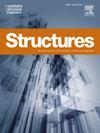Seismic behavior and repairability of new composite concrete block wall with distributed slipping damage
IF 3.9
2区 工程技术
Q1 ENGINEERING, CIVIL
引用次数: 0
Abstract
In this paper, a new composite concrete block is proposed, matching the thin-layer masonry process, which can reduce the construction cost and improve the efficiency. To investigate the seismic behavior of this new composite concrete block wall (NCCBW), horizontal low circumferential reciprocating load tests of two NCCBW specimens with different axial compression ratios are carried out. The test results show that the NCCBW has distributed slipping damage characteristics, good bearing and deformation capacity, and the ductility coefficients of the specimens W1 and W2 with axial compression ratios of 1.0 and 1.6 are 6.31 and 4.82, respectively. Afterwards, based on the test results, the seismic shear capacity calculation method applicable to NCCBW is modified and established, and the average error between the predicted values and the corresponding test results is 4.5 %, which provides a reference for the engineering application of this structure. Finally, the specimen W1 is repaired using the textile reinforced mortar (named specimen RW) and then tested again. The test results show that NCCBW has good repairability, and the peak bearing capacity of the specimen RW is 24.7 % higher than that of the specimen W1, and it still maintains good deformation capacity and integrity after interface separation. In summary, this NCCBW, with good seismic behavior and post-earthquake repairability, is particularly suitable for earthquake-prone areas in real-world scenarios.
求助全文
约1分钟内获得全文
求助全文
来源期刊

Structures
Engineering-Architecture
CiteScore
5.70
自引率
17.10%
发文量
1187
期刊介绍:
Structures aims to publish internationally-leading research across the full breadth of structural engineering. Papers for Structures are particularly welcome in which high-quality research will benefit from wide readership of academics and practitioners such that not only high citation rates but also tangible industrial-related pathways to impact are achieved.
 求助内容:
求助内容: 应助结果提醒方式:
应助结果提醒方式:


